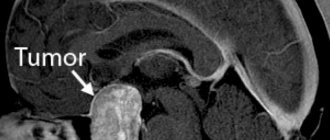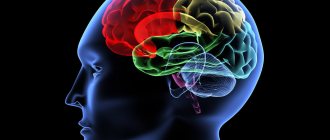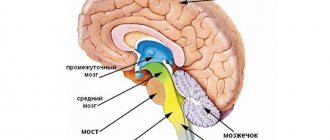The pituitary gland is an appendage of the brain, one of the main organs of the endocrine system, in the form of a round formation, which is located on the lower surface of the brain in a bone pocket called the sella turcica; it produces hormones that affect human growth.
The pituitary gland is also called the pituitary gland. It is the center of the endocrine system. This appendage is located in the brain, below the cerebral hemispheres in the sella turcica. The diameter of the pituitary gland in a healthy person is only 1.5 cm, but despite this, it is quite difficult to overestimate it. For example, it produces substances that control metabolism and controls the reproductive system.
This is where the pituitary gland is located in the brain.
Functions of the pituitary gland
For a long time, scientists could not determine what the pituitary gland is and what work it performs in the central nervous system. A large number of versions were put forward, which was reflected even in art. For example, according to M. A. Bulgakov’s story “The Heart of a Dog,” this appendage of the brain is responsible for human appearance and behavior.
Based on recent studies of the central nervous system and its departments, it follows that the pituitary gland is a secretory structure. It produces the following substances:
- STH (somatotropic hormone);
- TSH (thyroid-stimulating hormone) – stimulates the thyroid gland;
- Prolactin – controls the production of breast milk;
- Melanostimulating hormone – controls the production and distribution of melanin pigment;
- ACTH affects the functioning of the adrenal glands.
These hormones are synthesized primarily by the anterior lobe of the pituitary gland - the adenohypophysis. Its middle part controls the absorption and excretion of fats from the body, and the rear part produces vasopressin and oxytocin. The first regulates the water-salt balance in the body, the second stimulates the muscular activity of the uterus in women during childbirth.
The pituitary gland is not an isolated organ - its functioning is coordinated with other parts of the central nervous system with the help of subcortical nodes located in the thickness of the white matter.
The structure of the pituitary gland of the brain
Symptoms of pituitary gland dysfunction
Signs of impaired hormone secretion in the brain often go unnoticed for a long time - they are attributed to stress, fatigue and adverse environmental influences. It is worth paying attention to the following manifestations of pathology:
- Fatigue;
- Lack of strength;
- Lethargy;
- Dry skin – small cracks, wounds;
- Rapid dehydration of the body;
- Weight gain due to an increase in the volume of adipose tissue;
- Poor appetite;
- Forgetfulness;
- Mental disorders – apathy, depression, mood swings;
- Changing the timbre of the voice;
- Overgrowth of bone tissue in certain areas of the body (for example, with acromegaly).
Symptoms of pituitary hyperfunction in women most often include infertility and milk production from the mammary glands in the absence of breastfeeding or pregnancy, irregular menstruation, decreased libido, and systemic headaches.
In half of the clinical cases, an increase in the pituitary gland of the brain occurs due to the appearance of neoplasms in the gland; the reasons for their occurrence can be different: head injury, stress or genetic predisposition.
Simmonds syndrome
Occurs against the background of atrophy of the tissues of the pituitary gland of the brain. The pathological process can masquerade as other pathologies for a long time, which is explained by the ability of healthy cells to take over the functions of the affected ones. When this balance is disturbed, the following symptoms appear:
- A sharp change in body weight (both up and down);
- Early baldness, tooth decay;
- Dehydration of the skin;
- Loss of strength, lack of appetite;
- Hypotension;
- Gastrointestinal disorders;
- Slowing down metabolic processes in the body;
- Sexual dysfunction.
In severe cases, hallucinations and convulsions are observed.
Sheehan syndrome
The pathology is expressed by necrosis of pituitary tissue in women who have recently given birth. The process occurs rapidly - in the first days after birth. The main manifestations are: bleeding, decreased blood pressure, severe pain, which is replaced by shock. The most common causative factor is diabetes mellitus.
Pituitary dwarfism
Insufficient secretion of the hormone somatotropin provokes a lag in the growth and development of human internal organs. Symptoms of the pathology are:
- Dwarfism – the maximum height of a person with this disease is less than 147 cm;
- Inhibition of the development of reproductive and internal organs;
- Slow heart rate, hypotension;
- The immaturity of the emotional-volitional sphere of the psyche persists even into adulthood.
Diabetes insipidus
The pathology is accompanied by severe thirst and profuse urination and sweating. Disturbances in sleep-wake processes are also noted. The amount of fluid lost by the body per day ranges from 5-20 liters. When water consumption decreases, the body quickly dehydrates.
Acromegaly
Violation of the excretory ability of the adenohypophysis leads to the proliferation of bone tissue and enlargement of the limbs, nose, ears, lower jaw, and forehead. Changes develop against the background of excessive production of growth hormone. Due to the rapid growth of bone tissue, patients experience joint and muscle pain, blurred vision, and disruptions in the functioning of the circulatory and respiratory systems.
Gigantism
It develops against the background of excessive production of the hormone somatotropin. It is characterized by an accelerated growth rate of the body and limbs - the child’s height can exceed 2 meters with a relatively small head volume. Patients with this pathology also have other pathologies of the central nervous system, mental disorders, and sexual dysfunction.
Itsenko Cushing's disease
Changes in the body occur against the background of excessive production of the hormone cortisol. Despite the fact that it is produced by the adrenal glands, its production is controlled by the brain, or more precisely, the pituitary gland. The cause of the pathology is a corticotrophic benign tumor.
The following symptoms are noted:
- Red round face;
- Thinning of the skin;
- Fat deposits on the abdomen;
- Hirsutism;
- Hyperpigmentation of the skin in the elbows, neck and areas of friction with clothing;
- Hypertension;
- Decreased bone density;
- Mental disorders.
This pathology is difficult to treat. Full recovery is possible only with a mild form of the disease.
Hyperprolactinemia
Excessive production of prolactin by the pituitary gland of the brain in the absence of pregnancy leads to dysfunction of the reproductive system. In women, this manifests itself in disruption of the monthly cycle, infertility, and the release of a small amount of milk.
In men, changes in figure, namely swelling of the mammary glands, formation of fat deposits on the waist and buttocks, erectile dysfunction, decreased libido, brittle bones, and regular headaches.
Pituitary gland disorders
A common disorder of the pituitary gland is the formation of tumors in it. However, such tumors are not malignant. They can be of two types;
- secretory – produces too many hormones;
- nonsecretory – keeps the pituitary gland from functioning optimally.
The pituitary gland can increase or decrease not only due to pregnancy or age-related changes, but also due to the action of harmful factors:
- long-term use of oral contraceptives;
- inflammatory process;
- traumatic brain injury;
- surgical intervention in the brain;
- hemorrhage;
- cystic and tumor formations;
- radiation exposure.
Pituitary diseases in women cause menstrual irregularities and infertility; in men they lead to erectile dysfunction and metabolic disorders.
Treatment of pituitary diseases, depending on the symptoms of the pathology, can be carried out using various methods:
- medicinal;
- surgical;
- radiation therapy.
The fight against pituitary gland dysfunction can take a significant period of time, and in most cases the patient has to take medications for life.
Treatment of pathologies
Before treating pituitary gland dysfunction in the brain, you should first check its functionality. They start with a blood test to determine the content of hormonal active substances in it. Exceeding the threshold values indicates hyperfunction, the cause of which is most often a benign neoplasm.
Therefore, at the next stage of diagnosis, the patient undergoes an MRI of the brain. It will allow you to visualize the tumor and help determine its characteristics: size, location and density.
Based on these indicators, the doctor prescribes treatment. This may be corrective drug therapy, surgical removal, or a set of therapeutic measures.
The structure of the posterior and anterior lobes
Tasks of the posterior pituitary gland
In the absence of the possibility of a detailed examination of the brain, treatment will be based on data obtained from a blood test. Thus, a deviation in the content of the following hormones in it indicates dysfunction or hyperfunction of the posterior part of the pituitary gland (neurohypophysis). These include:
- Asparotocin;
- Vasopressin;
- Vasotocin;
- Valitocin;
- Glumitocin;
- Isotocin;
- Mesotocin;
- Oxytocin.
Violation of the production process of any of them causes multiple abnormalities, including sexual dysfunction, obesity or, conversely, sudden weight loss.
Function of the anterior pituitary gland
The adenohypophysis controls:
- The work of the structures of the endocrine system. This is accomplished through the release of tropic hormones, which activate the production of hormones by the endocrine glands.
- Protein synthesis in cells, glucose formation and fat breakdown, as well as body growth.
- Lactation, growth and metabolic processes in the body, sexual behavior.
Pathology of pituitary gland functions
Pathological changes in the structure of the pituitary gland lead to dysfunction of this part of the brain, which is reflected in its hyper- or hypoactivity. Deviations in the process of hormone synthesis provoke the development of concomitant diseases.
Functions of the pituitary gland
The reason why the pituitary gland began to produce larger amounts of the hormone could be trauma, vascular diseases, abnormalities in brain development, as well as a disruption in its connection with the hypothalamus, which is capable of stimulating the growth of tissues of this structure due to benign tumor cells. This neoplasm can become hormonally active, that is, produce additional amounts of hormones.
Hypofunction
Characterized by insufficiently active (or complete absence) production of hormonal active substances. May cause dysfunction of internal organs.
What is the pituitary gland
The content of the article
The pituitary gland is a tiny endocrine organ located at the base of the brain, in a bone formation, the so-called “sella turcica”. It is oval in shape and about the size of a pea - about 10 mm in length and 12 mm in width. Normally, in a healthy person, the weight of the pituitary gland is only 0.5-0.9 g. In women, it is more developed due to the synthesis of the hormone prolactin, which is responsible for the manifestation of the maternal instinct. The amazing ability of the pituitary gland is that it increases during pregnancy, and after childbirth the previous size is not restored.
The pituitary gland is largely controlled by the hypothalamus, which lies above and slightly behind the gland. These two structures are connected by the pituitary, or funnel-shaped, stalk. The hypothalamus is capable of sending stimulating or inhibitory (suppressive) hormones to the pituitary gland, thereby regulating its effect on other endocrine glands and the body as a whole.
The “conductor of the endocrine orchestra” consists of the anterior lobe, intermediate zone and posterior lobe. The anterior lobe is the largest (occupies 80%) and produces and releases large amounts of hormones. The posterior lobe does not produce hormones as such - this is done by nerve cells in the hypothalamus - but it releases them into the circulation. The intermediate zone produces and secretes melanocyte-stimulating hormone.
The pituitary gland is involved in several body functions, including:
- regulation of the activity of other organs of the endocrine system (adrenal glands, thyroid and gonads);
- control of growth and development of organs and tissues;
- control over the functioning of internal organs - kidneys, mammary glands, uterus in women.











